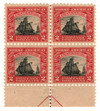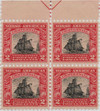
# 620 - 1925 2c Norse-American Centennial: Sloop Restaurationen
U.S. # 620
1925 Norse-American
• Commemorates the 100th anniversary of the first arrival of Norwegians in America on October 9, 1825.
Type of Stamp: Commemorative
First Day of Issue: May 18, 1925
First Day City: Algona, IA; Benson, MN; Northfield, MN; Decorah, IA; Minneapolis, MN; St. Paul, MN; Washington, D.C.
Quantity Issued: 9,104,983
Printing Method: Flat Plate, printed in sheets of 100 stamps 10 by 10
Printed by: Bureau of Engraving and Printing
Perforation: 11
Color: Carmine and black
Why Issued: Issued to publicize the June 6-9, 1925 Norse-American Centennial celebration held at the Minnesota State Fair and commemorate the Oct 9, 1825 arrival of first Norwegians.
Design: The central design shows the ship Restauration as it’s supposed to have looked in 1825. The artist used a painting of its sister ship as a model as no art existed of the Restauration. There is a second ship in the background on the right side of the stamp.
Design details: Horizontal stamp, at top NORSE-AMERICAN in a straight line, followed by CENTENNIAL in a curved frame. Left date 1825, right date 1925. Sides show a dragon from the prow of Viking longship, Viking shield under the dragon. Bottom, large 2, three lines of type. UNITED STATES, POSTAGE, TWO CENTS.
Why definitive size? We don’t know why. It’s unusual for a commemorative to be definitive size.
Printing: Printed on a flat-plate press in sheets of 100 with selvage on four side. Most flat-plate sheets have straight edges on two sides. The sheet has two plate numbers on the top of the sheet, one for each color, and four arrows in the center of the selvage, top, left, bottom, right. The arrows created a ‘center-line’ block in the center of the sheet. Each sheet has one plate number block of 8 stamps. The black plate number is over the 4th stamp and second color over the 7th stamp.
Why no inverts? The Bureau of Engraving and Printing had two big challenges with this issue. One was avoiding creating errors like the 1918 inverted Jenny with the plane flying upside-down. The second, and equally difficult problem, was to keep the 2c and 5c plates separate, as well as the partly printed sheets. Any mix-up might have the 5c Viking ship vignette printed with the 2c frame or visa-versa.
More facts: This was the first 2-color commemorative since the 1901 Pan-American series. The two-cent stamp paid the first-class letter rate.
Nice sheets very difficult to find. After 100 years most surviving sheets have hinges or an adhesive applied on the gum side to repair separations.
The 2c stamp was so popular the Philatelic Agency in Washington limited sales to 25 stamps per order. That 25-stamp sales limit makes the 2c sheet extra scarce.
The black ink caused the vignette plates to wear out quickly, and so, twice as many black plates were needed compared to the carmine frame.
First Day Cities were in areas near the Norse-American Centennial celebration at the Minnesota State Fair June 6-9, 1925, and areas with many Norse-Americans.
The Set: Two stamps were issued, #620-21. The 2c is carmine and black. The 5c is dark blue and black. The 5c stamp shows a replica Viking ship.
History of the 1825 Voyage: On October 9, 1825, the sloop Restauration arrived in the United States, marking what is often considered the first organized migration from Norway to the U.S.
Norsemen from Greenland and Iceland were the first Europeans to reach America, led by Leif Erikson around the year 1000. They founded a settlement in present-day Newfoundland, Canada, but didn’t remain due to conflicts with the indigenous people.
Later, in the 1600s, small groups of Norwegians settled in America, particularly New York and Pennsylvania. But the first large migration wouldn’t occur until 1825. At that time, a group of Norwegians joined together to travel to America for religious reasons. They were members of the Religious Society of Friends (Quakers) and the Haugeans.
On July 4, 1825, a group of 52 Norwegian immigrants boarded the single-masted sloop Restauration (also known as Restauration, Restoration, Restaurasjonen, and Restorasjon) in Stavanger harbor. Often called the Norwegian Mayflower, it was only about half the size of that famous ship. During the three-month journey, the ship’s occupancy increased by one, with the birth of Margaret Allen Larsen.
The Restauration finally arrived in New York on October 9, 1825. The small ship, 54 feet long and 16 feet wide, had more passengers that allowed by the 1819 Passenger Act. The U.S. welcomed the immigrants by impounding the ship, arresting the captain, and imposing a stiff fine. Happily, for the captain, on November 15, 1825 President John Quincy Adams freed the caption, rescinded the fine, and released the ship.
October 9, the day the Norwegians arrived, is celebrated in the U.S., as Leif Ericson Day, Leif Ericson, Norse explorer is believed to be the first European to reach North America.
U.S. # 620
1925 Norse-American
• Commemorates the 100th anniversary of the first arrival of Norwegians in America on October 9, 1825.
Type of Stamp: Commemorative
First Day of Issue: May 18, 1925
First Day City: Algona, IA; Benson, MN; Northfield, MN; Decorah, IA; Minneapolis, MN; St. Paul, MN; Washington, D.C.
Quantity Issued: 9,104,983
Printing Method: Flat Plate, printed in sheets of 100 stamps 10 by 10
Printed by: Bureau of Engraving and Printing
Perforation: 11
Color: Carmine and black
Why Issued: Issued to publicize the June 6-9, 1925 Norse-American Centennial celebration held at the Minnesota State Fair and commemorate the Oct 9, 1825 arrival of first Norwegians.
Design: The central design shows the ship Restauration as it’s supposed to have looked in 1825. The artist used a painting of its sister ship as a model as no art existed of the Restauration. There is a second ship in the background on the right side of the stamp.
Design details: Horizontal stamp, at top NORSE-AMERICAN in a straight line, followed by CENTENNIAL in a curved frame. Left date 1825, right date 1925. Sides show a dragon from the prow of Viking longship, Viking shield under the dragon. Bottom, large 2, three lines of type. UNITED STATES, POSTAGE, TWO CENTS.
Why definitive size? We don’t know why. It’s unusual for a commemorative to be definitive size.
Printing: Printed on a flat-plate press in sheets of 100 with selvage on four side. Most flat-plate sheets have straight edges on two sides. The sheet has two plate numbers on the top of the sheet, one for each color, and four arrows in the center of the selvage, top, left, bottom, right. The arrows created a ‘center-line’ block in the center of the sheet. Each sheet has one plate number block of 8 stamps. The black plate number is over the 4th stamp and second color over the 7th stamp.
Why no inverts? The Bureau of Engraving and Printing had two big challenges with this issue. One was avoiding creating errors like the 1918 inverted Jenny with the plane flying upside-down. The second, and equally difficult problem, was to keep the 2c and 5c plates separate, as well as the partly printed sheets. Any mix-up might have the 5c Viking ship vignette printed with the 2c frame or visa-versa.
More facts: This was the first 2-color commemorative since the 1901 Pan-American series. The two-cent stamp paid the first-class letter rate.
Nice sheets very difficult to find. After 100 years most surviving sheets have hinges or an adhesive applied on the gum side to repair separations.
The 2c stamp was so popular the Philatelic Agency in Washington limited sales to 25 stamps per order. That 25-stamp sales limit makes the 2c sheet extra scarce.
The black ink caused the vignette plates to wear out quickly, and so, twice as many black plates were needed compared to the carmine frame.
First Day Cities were in areas near the Norse-American Centennial celebration at the Minnesota State Fair June 6-9, 1925, and areas with many Norse-Americans.
The Set: Two stamps were issued, #620-21. The 2c is carmine and black. The 5c is dark blue and black. The 5c stamp shows a replica Viking ship.
History of the 1825 Voyage: On October 9, 1825, the sloop Restauration arrived in the United States, marking what is often considered the first organized migration from Norway to the U.S.
Norsemen from Greenland and Iceland were the first Europeans to reach America, led by Leif Erikson around the year 1000. They founded a settlement in present-day Newfoundland, Canada, but didn’t remain due to conflicts with the indigenous people.
Later, in the 1600s, small groups of Norwegians settled in America, particularly New York and Pennsylvania. But the first large migration wouldn’t occur until 1825. At that time, a group of Norwegians joined together to travel to America for religious reasons. They were members of the Religious Society of Friends (Quakers) and the Haugeans.
On July 4, 1825, a group of 52 Norwegian immigrants boarded the single-masted sloop Restauration (also known as Restauration, Restoration, Restaurasjonen, and Restorasjon) in Stavanger harbor. Often called the Norwegian Mayflower, it was only about half the size of that famous ship. During the three-month journey, the ship’s occupancy increased by one, with the birth of Margaret Allen Larsen.
The Restauration finally arrived in New York on October 9, 1825. The small ship, 54 feet long and 16 feet wide, had more passengers that allowed by the 1819 Passenger Act. The U.S. welcomed the immigrants by impounding the ship, arresting the captain, and imposing a stiff fine. Happily, for the captain, on November 15, 1825 President John Quincy Adams freed the caption, rescinded the fine, and released the ship.
October 9, the day the Norwegians arrived, is celebrated in the U.S., as Leif Ericson Day, Leif Ericson, Norse explorer is believed to be the first European to reach North America.






















